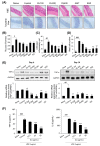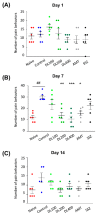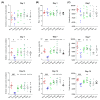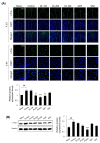Alleviation of Irritable Bowel Syndrome-Like Symptoms and Control of Gut and Brain Responses with Oral Administration of Dolichos lablab L. in a Mouse Model
- PMID: 30309025
- PMCID: PMC6213091
- DOI: 10.3390/nu10101475
Alleviation of Irritable Bowel Syndrome-Like Symptoms and Control of Gut and Brain Responses with Oral Administration of Dolichos lablab L. in a Mouse Model
Abstract
Irritable bowel syndrome (IBS) is a common gastrointestinal disorder manifesting as unexplained abdominal pain and bowel habit changes. The pathogenesis of post-infectious IBS is associated with gut⁻brain axis dysfunction, including low-grade colonic inflammation and anxiety-related long-term brain changes. This study analyzed the efficacy of a standardized extract of Dolichos lablab L. extract (DL), a bean species, in an IBS mouse model resembling post-infectious, diarrhea-dominant IBS. Using a zymosan-induced animal IBS model, we found that oral administration of DL significantly attenuated zymosan-induced increases in colonic macroscopic scores and minimized weight loss without affecting food intake. In the DL-treated mice, the mast cell count and tumor necrosis factor-α level in the colon markedly decreased, similar to results in sulfasalazine-treated mice and in mice with lipopolysaccharide-stimulated bone marrow-derived mast cells. The number of visceral pain-related behaviors was much lower in the DL-treated mice. Anxiety-like behaviors significantly improved, comparable to that after treatment with amitriptyline. The c-Fos expression level in the prefrontal cortex was significantly reduced. Our data suggest that DL could be beneficial for treating IBS by acting on the gut and brain.
Keywords: Dolichos lablab L.; anxiety; colonic inflammation; gut–brain axis; irritable bowel syndrome; mouse model; pain; zymosan-induced IBS.
Conflict of interest statement
The authors declare no conflicts of interest.
Figures








Similar articles
-
Administration of Wasabia koreana Ameliorates Irritable Bowel Syndrome-Like Symptoms in a Zymosan-Induced Mouse Model.J Med Food. 2017 May;20(5):474-484. doi: 10.1089/jmf.2016.3844. Epub 2017 Apr 28. J Med Food. 2017. PMID: 28452565 Free PMC article.
-
The traditional herbal medicines mixture, Banhasasim-tang, relieves the symptoms of irritable bowel syndrome via modulation of TRPA1, NaV1.5 and NaV1.7 channels.J Ethnopharmacol. 2023 Aug 10;312:116499. doi: 10.1016/j.jep.2023.116499. Epub 2023 Apr 13. J Ethnopharmacol. 2023. PMID: 37059250
-
Atractylodes macrocephala Koidz Alleviates Symptoms in Zymosan-Induced Irritable Bowel Syndrome Mouse Model through TRPV1, NaV1.5, and NaV1.7 Channel Modulation.Nutrients. 2024 May 29;16(11):1683. doi: 10.3390/nu16111683. Nutrients. 2024. PMID: 38892616 Free PMC article.
-
Rifaximin for the treatment of diarrhea-predominant irritable bowel syndrome.Expert Rev Gastroenterol Hepatol. 2016;10(4):431-42. doi: 10.1586/17474124.2016.1140571. Epub 2016 Mar 1. Expert Rev Gastroenterol Hepatol. 2016. PMID: 26753693 Review.
-
Abdominal pain in Irritable Bowel Syndrome: a review of putative psychological, neural and neuro-immune mechanisms.Brain Behav Immun. 2011 Mar;25(3):386-94. doi: 10.1016/j.bbi.2010.11.010. Epub 2010 Nov 20. Brain Behav Immun. 2011. PMID: 21094682 Review.
Cited by
-
The Efficacy and Safety of NOVAponin (Dolichos lablab Linne Extract Powder) in Mild Functional Dyspepsia: A Single-center, Randomized, Double-Blind, Placebo-controlled Study.J Neurogastroenterol Motil. 2024 Oct 30;30(4):468-479. doi: 10.5056/jnm23180. J Neurogastroenterol Motil. 2024. PMID: 39397624 Free PMC article.
-
Dolichos lablab L. extracts as pharmanutrient for stress-related mucosal disease in rat stomach.J Clin Biochem Nutr. 2020 Jul;67(1):89-101. doi: 10.3164/jcbn.20-11. Epub 2020 Jun 11. J Clin Biochem Nutr. 2020. PMID: 32801474 Free PMC article.
-
Shenling Baizhu Powder Alleviates TNBS-Induced Colitis in Rats by Improving Intestinal Epithelial Permeability and Inhibiting Inflammation Through the TLR5/MyD88/NF-κB Pathway.Front Pharmacol. 2022 Apr 28;13:883918. doi: 10.3389/fphar.2022.883918. eCollection 2022. Front Pharmacol. 2022. PMID: 35571126 Free PMC article.
-
Animal Models for Functional Gastrointestinal Disorders.Front Psychiatry. 2020 Nov 11;11:509681. doi: 10.3389/fpsyt.2020.509681. eCollection 2020. Front Psychiatry. 2020. PMID: 33262709 Free PMC article. Review.
-
Effects of red ginseng on gut, microbiota, and brain in a mouse model of post-infectious irritable bowel syndrome.J Ginseng Res. 2021 Nov;45(6):706-716. doi: 10.1016/j.jgr.2021.03.008. Epub 2021 Apr 3. J Ginseng Res. 2021. PMID: 34764725 Free PMC article.
References
-
- Feng B., La J.H., Schwartz E.S., Gebhart G.F. Irritable bowel syndrome: Methods, mechanisms, and pathophysiology. Neural and neuro-immune mechanisms of visceral hypersensitivity in irritable bowel syndrome. Am. J. Physiol. Gastrointest. Liver Physiol. 2012;302:G1085–G1098. doi: 10.1152/ajpgi.00542.2011. - DOI - PMC - PubMed
MeSH terms
Substances
Grants and funding
LinkOut - more resources
Full Text Sources
Medical

